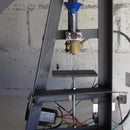Introduction: LPG Furnace Burner.
What makes this different from the majority of gas burners is the welded construction and the fact that I used a bicycle wheel axle for the bulkhead, the piece that transitions the gas hose from the bottle to the gas jet.
Tools used were a welder, lathe and angle grinder.
Step 1: The Venturi and Gas Jet.
I decided to build my own venturi seeing as none were available locally in South Africa.
I started off with a 1 inch to 2 inch concentric reducer and welded a U bracket on the wider end. This was drilled out to 10mm seeing as I dont know what size and pitch the bicycle axle was. The axle had a 5.5mm bore and so it was tapped M6 on the one end for the MIG jet and drilled out to 8mm for the 90 degree hose barb.
Only the hose barb was brazed. The jet might need to be up sized to a 1.2mm orifice so I left it threaded with teflon tape.
A bicycle axle nut was sliced in half to fasten the bulkhead and make it adjustable if need be.
The air choke disk is 2mm steel plate which I spun on the lathe to get it smoothly concentric. I tapped the center hole with a 1/8 BSP 28 tap and it turns freely on the axle.
Step 2: Main Tube and Flare.
I used a 300mm long 1 inch schedule 40 pipe and welded on a 2 inch length of 45mm dia mild steel for the flare.
I wondered what would happen with a shorter main tube and cut it down to 200mm and added a flare.
The result was the flame blow out at anything slightly higher than the minimum on the regulator.
Likewise with increasing the jet size to 0.95mm, blowout at higher pressures and a very rich flame with lots of orange flares shooting off.
The flare is needed to transition the 20 psi LPG to the atmospheric pressure in the furnace. It also creates a slight vacuum in the front of burner tube supposedly increasing performance.
Once you have all the components, it shouldn't take longer than a day to assemble.
Step 3: Bench Testing.
While my diy Babington burner worked for melting aluminium, it doesn't get hot enough to melt copper, hence the upgrade to a LPG burner.

Participated in the
Metal Contest













